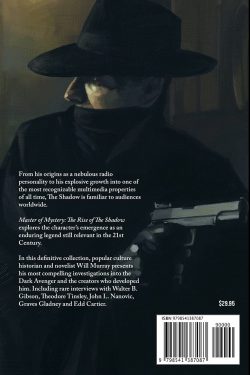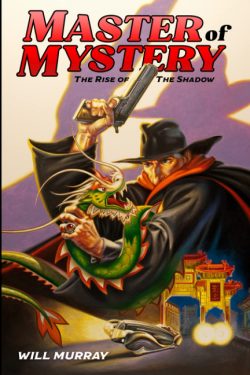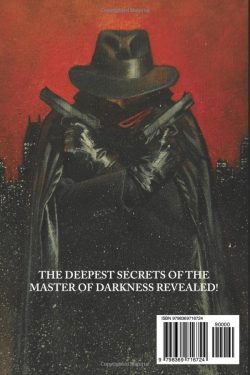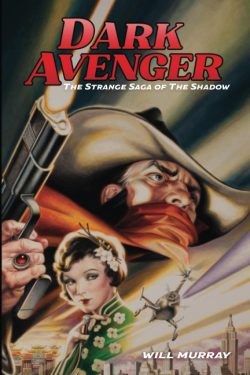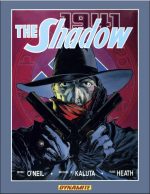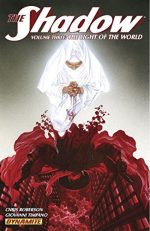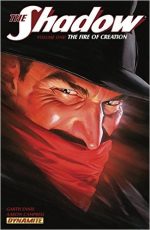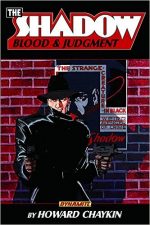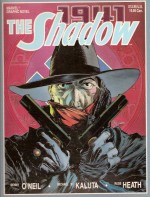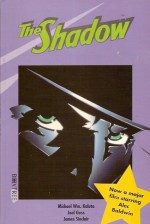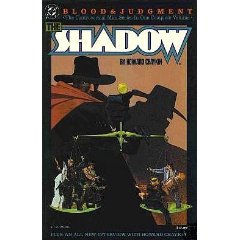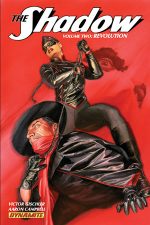
By Victor Gischler, Jack Herbert, Aaron Campbell, Giovanni Timpano & various (Dynamite Entertainment)
ISBN: 978-1-60690-361-2
In the early 1930s, The Shadow gave thrill-starved readers their measured doses of extraordinary excitement via cheaply produced pulp periodical novels, and over the mood-drenched airwaves, through his own radio show.
“Pulps†were published in every style and genre in their hundreds every month, ranging from the truly excellent to the pitifully dire, but for exotic or esoteric adventure-lovers there were two star who outshone all others. The Superman of his day was Doc Savage, whilst the premier dark, relentless creature of the night dispensing terrifying grim justice was the putative hero under discussion here.
Radio series Detective Story Hour – based on stand-alone yarns from the Street & Smith publication Detective Story Magazine – used a spooky voiced narrator (variously Orson Welles, James LaCurto or Frank Readick Jr.) to introduce each tale. He was dubbed “the Shadow†and from the very start on July 31st 1930, he was more popular than the stories he highlighted.
The Shadow evolved into a proactive hero solving instead of narrating mysteries and, on April 1st 1931, began starring in his own printed pulp series, written by the incredibly prolific Walter Gibson under the house pseudonym Maxwell Grant. On September 26th 1937 the radio show officially became The Shadow with the eerie motto “Who knows what evil lurks in the hearts of Men? The Shadow knows!†ringing out unforgettably over the nation’s airwaves.
Over the next eighteen years 325 novels were published, usually at the rate of two a month. The uncanny crusader spawned comicbooks, seven movies, a newspaper strip and all the merchandising paraphernalia you’d expect of a superstar brand.
The pulp series officially ended in 1949 although Gibson and others added to the canon during the 1960s when a pulp/fantasy revival gripped America, generating reprinted classic stories and a run of new adventures as paperback novels.
In graphic terms The Shadow was a major player. His national newspaper strip – by Vernon Greene – launched on June 17th 1940 and when comicbooks really took off the Man of Mystery had his own four-colour title; running from March 1940 to September 1949.
Archie Comics published a controversial contemporary comicbook in 1964-1965 under their Radio/Mighty Comics imprint, by Robert Bernstein, Jerry Siegel, John Rosenberger and latterly Paul Reinman; and in 1973 DC acquired the rights to produce a captivating, brief and definitive series of classic comic adventures unlike any other superhero title then on the stands.
DC periodically revived the venerable vigilante. After the runaway success of Crisis on Infinite Earths, The Dark Knight Returns and Watchman, Howard Chaykin was allowed to utterly overhaul the vintage feature. This led to further, adult-oriented iterations (and even one cracking outing from Marvel) before Dark Horse assumed the license of the quintessential grim avenger for the latter half of the 1990s and beyond.
Dynamite Entertainment picked up the option in 2011 and, whilst republishing many of those other publisher’s earlier efforts, began a series of new monthly Shadow comics.
Set in the turbulent 1930s and war years that followed, these were crafted by some of the top writers in the industry, each taking their shot at the immortal legend, and all winningly depicted by a succession of extremely gifted illustrators.
This second volume – collecting #7-12 of the monthly comicbook from 2013 – comes courtesy of Victor Gischler (Gun Monkeys, Deadpool: Merc with a Mouth, Kiss Me Satan), again throwing a spotlight on the increasing deadly geopolitics of a civilisation sliding inexorably into another World War….
His scripts were variously realised by Jack Herbert, Aaron Campbell, Giovanni Timpano, Ivan Nunes & Carlos Lopez, and the action opens with a self-contained prelude that begins with the Master of the Macabre suffering from uncharacteristic bad dreams…
Very few people know that the black-cloaked fist of final retribution known as The Shadow masquerades by day as abrasive, indolent playboy Lamont Cranston. Most are agents in his employ and they are all aware of his semi-mystical abilities to detect thoughts and cloud the minds of men, but not that in the past few days those abilities have seemingly waned and led to the death of an innocent…
Engaging veteran Great War pilot Miles Crofton, Cranston embarks on a journey to the Himalayan region where he long ago studied under august adepts of the arcane. However, his voyage is interrupted in Nepal when he encounters a brutal bandit leader dubbed Red Raja. This thuggish crimelord seems to have powers and abilities similar and equal to his own…
Eschewing immediate confrontation, Cranston delves deep into the past and eventually learns the Raja also studied with the esoteric “Mastersâ€. Tragically, when his innate evil nature forced them to expel him, the student returned with men and guns; wiping out the entire enclave of puissant accumulated knowledge…
Armed with information and fuelled by righteous fury, The Shadow then assaults Red Raja’s fortress, single-handedly eradicating his army of rogues before enacting final judgement…
Weeks later, vacationing in Paris whilst Miles has their plane repaired, the restless Shadow passes his time hunting down human predators and becomes emotionally embroiled in a missing persons case.
The trail leads to a grand soiree at the Spanish Embassy where Cranston makes a particular splash with the assorted dignitaries and persons of wealth and high station, particularly after loudly declaring that he is an arms dealer with product to sell.
It is 1937 and the civil war in Spain has all but stalled, with both sides afflicted by attrition and exhaustion…
Horrified Ambassador Ramirez is only too happy to fob off the tiresome Cranston on his military attaché. As soon as he sees the devastating Major Esmeralda Aguilar, the Shadow knows she is no ordinary woman…
The swaggering millionaire is only too eager to ditch the stuffy party with the exotic spy, but their intimate drive through the City of Lights is almost ended by a machine gun attack. Then Cranston discovers just how dangerous his companion truly is…
The next day Miles resurfaces with news on a freighter full of munitions headed for Spain and the final clue to the disappearances the Shadow has been investigating. Even with mental faculties and powers diminished and compromised, the Dark Avenger is clear on where his next destination lies…
Intercepting the gunrunners as they seek to offload their illicit cargo at a Spanish port, the Shadow dispenses his brand of justice before vanishing, and twelve hours later Lamont Cranston arrives in Barcelona, unsure of what trick of fate or his own subconscious has brought him there.
His mystically-attuned senses go into overdrive once he meets an inoffensive British volunteer in the Socialist Brigade calling himself “George Orwellâ€â€¦
After befriending the oddly magnetic militiaman, Cranston excuses himself and resumes his trail of guns whilst Orwell returns to his unit in Aragon. Diligent hunting takes the Shadow to a warehouse where a gang led by a masked woman named Black Sparrow are attempting to sell the munitions to representatives of the underworld.
When the crooks try a double-cross they are savagely wiped out by the Sparrow as her men stand idly by, and from his hidden vantage point the Shadow realises just how extraordinary Major Aguilar truly is…
Soon the Avenger is risking spectacular airborne death; chasing her back to an ancient castle in the Aragon Region where he uncovers a bold scheme by an international cabal to place a third ruler on the throne of Spain. Of course, when he blazes in to end the conspiracy, Cranston finds more than he bargained for.
“El Rey†is far from the dominating despot he appears, and the true mastermind behind the plot is far more of a match for the Shadow than the grim guardian could possibly have anticipated.
And that’s when fate reveals the potential value of a certain nondescript British soldier of ideology and fortune…
This historically-flavoured jaunt then concludes with one last hurrah as Miles and Cranston belatedly return to New York just in time for the Shadow to fixate on a gang of ruthless bank robbers terrorising the city with their bold and lethal raids.
Broaching his contacts on the police force and rampaging through the ranks of the underworld, the Shadow turns the city upside down until at last a grudging tip takes him to a certain Chinatown whorehouse where a most exotic creature provides all the details he need to exact his vengeance on the guilty.
Now all that remains is to trigger the bloody end…
Dynamite publish periodicals with a vast array of cover variants and here a vast gallery features dozens of iconic alternate visions from Alex Ross, John Cassaday, Darwyn Cooke, Francesco Francavilla, Tim Bradstreet, Mike Mayhew, Michael Golden, Jack Herbert and Sean Chen to delight any art lover’s eyes and heart.
Sardonic, uncompromising and packed with subtle nuance, Revolution is a superb addition to the annals of the quintessential Dark Knight, and one no one addicted to action and mystery should be without.
The Shadow ® & © 2013 Advance Magazine Publishers Inc. d/b/a Conde Nast. All Rights Reserved.
